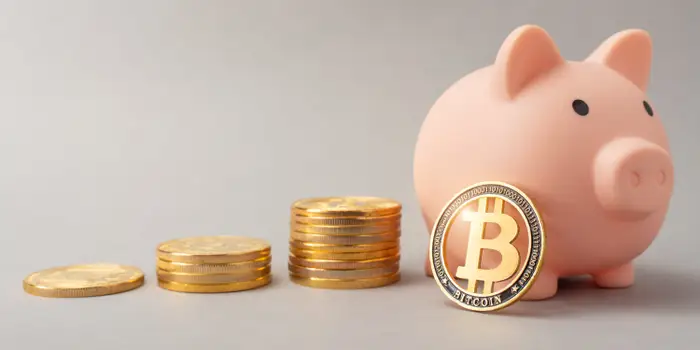Cryptocurrency IRA Account vs Precious Metals IRA Account: Evaluating Pros and Cons

When planning for retirement, investors have many options, including a traditional mix of stocks, bonds, and mutual funds and alternative investments like cryptocurrencies or precious metals such as silver.
Cryptocurrency IRAs have emerged as a modern choice for those looking to include digital currencies like Bitcoin in their retirement portfolios. They offer the potential for high returns amidst their known volatility.
Cryptocurrency IRAs allow investors to grow tax-deferred or tax-free retirement savings, as in Roth IRAs. However, they come with unique considerations around security and custodianship, potentially leading to higher fees and complexities.
Conversely, Silver IRAs present a more traditional option for investors seeking stability and a hedge against inflation.
Like other precious metals, silver has intrinsic value and has been a reliable store of wealth for thousands of years.
Investing in a Silver IRA account involves purchasing physical silver, which a custodian holds.
The prices of precious metals are generally less volatile than cryptocurrencies, but they also offer lower potential returns than cryptocurrency investments’ high-risk, high-reward nature.
To navigate these options effectively, individuals must weigh the advantages and disadvantages of both types of IRAs.
They should consider factors such as their risk tolerance, investment timeline, and the potential impact of market fluctuations on their retirement savings.
While Cryptocurrency IRAs and Silver IRAs present opportunities to diversify one’s retirement portfolio, they also have distinct pros and cons that must be carefully evaluated in the context of one’s overall retirement strategy. Websites like Smart Money Verified are excellent resources for additional information and reviews.
Understanding Cryptocurrency IRAs
Cryptocurrency Individual Retirement Accounts (IRAs) offer a modern twist on retirement savings, incorporating digital assets into traditional retirement planning strategies.
They operate under similar tax advantages as conventional IRAs, with the unique edge of providing access to the burgeoning crypto market.
Definition and Mechanics of Crypto IRAs
A Crypto IRA is a self-directed IRA that includes digital currencies in its investment portfolio.
Unlike standard IRAs, which are restricted to stocks and bonds, a Crypto IRA allows investors to invest in various digital assets, including Bitcoin, Ethereum, and other cryptocurrencies.
Blockchain technology facilitates crypto ownership and transactions within these IRAs, ensuring security and transparency.
One interacts with a Crypto IRA through specialized platforms that provide the necessary infrastructure to buy, sell, and store cryptocurrencies.
The digital currencies held within a Crypto IRA are capital assets, subject to capital gains tax rules.
However, utilizing the tax-advantaged structure of an IRA potentially allows these assets to grow either tax-deferred or tax-free, depending on whether it’s a Traditional or Roth IRA.
Variety of Cryptocurrencies in IRAs
IRAs that include cryptocurrency investors are not limited to Bitcoin (often called a Bitcoin IRA).
They have many options, including Ethereum, Litecoin, and other altcoins.
Each digital currency has unique attributes and associated risks, making the diversity within the IRA necessary for risk management.
Including various cryptocurrencies allows investors to hedge against the volatility inherent in digital markets.
With a self-directed Crypto IRA, investors can tailor their portfolios according to risk tolerance and investment objectives.
The available crypto assets represent a range of digital currencies, each with distinct market caps, liquidity, and acceptance levels within the broader financial ecosystem.
Exploring Silver IRA Accounts
Silver Individual Retirement Accounts (IRAs) offer a unique way to diversify one’s retirement portfolio through precious metals, a class of alternative assets. The inclusion of silver and other precious metals can provide a hedge against market volatility and inflation.
Benefits of Precious Metals IRAs
Precious metals IRAs provide tangible asset ownership within a retirement account. Common benefits include:
- Hedging against inflation: Precious metals historically retain value over time, contrary to paper currency.
- Diversification: Adding precious metals like silver helps diversify a portfolio, potentially lowering overall risk.
- Potential tax advantages: Like traditional IRAs, Silver IRA accounts may offer tax benefits, allowing for tax-deferred or tax-free asset growth.
Silver and Precious Metals as Alternative Assets
Alternative assets like silver stand apart from standard stocks and bonds. Silver IRAs particularly:
- Support portfolio stability: Silver can balance a portfolio, often moving inversely to stocks and bonds.
- Require specialist custodians: To handle the specific storage and security needs of physical assets; one must choose a custodian experienced in precious metals.
- Adhere to purity standards: Only certain forms of precious metals, such as .999 purity silver, are approved for inclusion in an individual retirement account.
Cryptocurrency IRAs provide a modern twist on retirement savings, blending cutting-edge blockchain technology with traditional individual retirement account structures. Investors consider the potentially high returns of cryptocurrencies like Bitcoin and the associated risks and volatility.
Advantages of Crypto IRAs
Tax Advantages: Crypto IRAs offer tax benefits similar to conventional IRAs. Investors may defer taxes on gains until distributions in a traditional IRA or potentially enjoy tax-free growth in a Roth IRA, as the Internal Revenue Service treats cryptocurrencies as property (Investopedia).
Diversification: One can diversify their retirement portfolio by including cryptocurrencies, which may not correlate directly with traditional asset markets. This can potentially reduce risk through asset allocation (Banks.com).
Potential for High Returns: Cryptocurrency IRAs may offer the potential for high returns. Given the past performance of assets like Bitcoin, some investors view them as a growth asset for a long-term retirement strategy.
Risks and Considerations of Crypto IRAs
Volatility: Cryptocurrencies are known for their price volatility. The value of digital assets can fluctuate widely, which may lead to significant account value changes in short periods, affecting one’s retirement savings.
Regulatory Risk: The regulatory environment for cryptocurrencies is uncertain and evolving. Future regulations could impact the value and legality of specific crypto assets held in IRAs.
Custodian Reliability: A cryptocurrency IRA requires working with a custodian to hold the assets. The security and reliability of the custodian are critical, as theft or loss can be detrimental to one’s retirement savings. It is vital to evaluate custodians’ track records and security measures before opening a crypto IRA (ZenLedger).
Complexity and Fees: Crypto IRAs can be more complex than traditional IRAs due to the intricacies of cryptocurrency trading and storage. This complexity may be accompanied by high fees, including initial setup fees, annual maintenance fees, and trading fees, which could diminish overall returns (Capitalize).
Benefits and Drawbacks of Silver IRAs
Silver Individual Retirement Accounts (IRAs) offer unique benefits and face certain limitations. Investors should weigh these factors carefully when considering a silver IRA as a component of their retirement portfolio.
Stability and Security of Silver IRAs
Stability: Silver, like other precious metals, has a long history as a store of value, often retaining its purchasing power during economic downturns.
Investors consider silver IRAs a hedge against inflation, economic uncertainty, and currency devaluation. Silver can provide a measure of security that is not always found in more volatile assets.
Security: Physical silver within an IRA is typically held in a secure depository, ensuring safety and adherence to IRS regulations for precious metal IRAs. This may provide peace of mind for investors concerned about the security risks of other asset classes.
Potential Limitations of Precious Metals IRAs
Liquidity and Flexibility: While silver is a tangible asset, it may not be as easily liquidated as stocks or bonds. This reduced liquidity could hinder an investor’s ability to adjust their retirement portfolio quickly in response to market changes.
Costs and Fees: Silver IRAs may incur higher fees than traditional or Roth IRAs due to the storage and insurance requirements for physical silver. These additional costs can impact the overall returns on investments.
Potential for Loss: Despite its reputation for stability, the price of silver can be volatile over the short term, leading to potential losses if the market price drops significantly.
Tax Advantages: Unlike stocks and bonds, precious metals like silver do not generate interest or dividends, which might limit the tax-advantaged growth potential that IRAs are known for. However, they can still provide potential tax benefits as the gains are not taxed until distribution.
Retirement Planning with an IRA
Individual retirement accounts (IRAs) offer diverse strategies and tax advantages when considering retirement planning. These accounts are pivotal for building a retirement portfolio tailored to one’s long-term financial goals.
Strategies for a Balanced Retirement Portfolio
A balanced retirement portfolio is crucial for financial security.
Investors can mitigate risk by incorporating a mix of stocks, bonds, and other assets, such as cryptocurrencies or precious metals.
Traditional IRAs and Roth IRAs are popular vehicles for retirement savings, each offering unique benefits for portfolio growth.
A Traditional IRA can include a variety of assets, whereas a Roth IRA allows tax-free growth and appeals to those who anticipate higher taxes in the future.
A SEP IRA offers higher funding limits for self-employed individuals, which can significantly impact their retirement nest egg.
When considering adding high-volatility assets like cryptocurrencies to an IRA, one should balance them with more stable investments to avoid jeopardizing one’s savings.
Tax Considerations and Benefits
IRAs provide significant tax benefits that can enhance one’s retirement savings.
With a Traditional IRA, contributions may be tax-deductible, lowering one’s taxable income. The earnings grow tax-deferred until withdrawn, typically in retirement when the investor may be in a lower tax bracket.
Contributions to a Roth IRA are made with after-tax dollars, offering the advantage of tax-free growth and withdrawals in retirement, providing a hedge against potential increases in income taxes.
Understanding the implications of capital gains taxes on investments within these accounts is vital.
For example, a Roth IRA does not impose capital gains taxes upon withdrawal, which can be advantageous for assets that have appreciated significantly.
Both Traditional and Roth IRAs can protect earnings from annual taxes, which helps compound interest work more efficiently in one’s favor. This starkly contrasts to a regular savings account, where interest earnings could be taxed yearly.
IRA Fees and Costs
Investors must be well-informed about the associated fees and costs when considering an Individual Retirement Account (IRA) that includes cryptocurrencies or precious metals like silver.
These can significantly affect the retirement investment’s overall value and potential growth over time.
Understanding Fees for Cryptocurrency and Silver IRAs
Setup Fee: Most specialized IRAs, such as those that permit holdings in cryptocurrencies or silver, often come with a setup fee. This initial charge covers the cost of opening and administering a new account.
The exact amount can vary widely depending on the provider. Still, for a self-directed IRA account, one might expect setup costs to be several hundred to a few thousand dollars.
Custodian Fees: These IRAs require a custodian to manage the account. Custodians typically charge an annual fee, a flat rate, or a percentage of the account value.
This fee pays for the safekeeping and administration of the account’s assets. The custody options for digital currencies might include self-custody or third-party management by platforms such as Kraken.
Trading Fees: Trading within an IRA incurs fees, including the costs of buying and selling cryptocurrencies like Bitcoin or silver.
These transaction fees are usually a percentage of the trade value, and they can add up, mainly if the account is actively managed with frequent trades.
Maintenance Fees: This is a regular charge for account upkeep, which may cover account reporting, statement delivery, and record keeping.
Both cryptocurrency and silver IRA providers may charge this fee, which could be a flat rate or scaled according to the account size.
Fee Transparency: The fees must be transparent.
Investors should always request a full disclosure of all fees associated with their IRA to avoid any unexpected charges.
Fee Comparison Between Crypto and Silver IRAs
Trading within both IRAs will incur transaction fees, but the structure may differ.
For instance, iTrustCapital offers competitive transaction fees for cryptocurrency trades at 1% per transaction, which can be more appealing than the fees associated with physical asset trades like silver.
The need for physical storage of silver in an IRA can result in higher custodian fees compared to digital assets like cryptocurrencies that rely on digital wallets.
However, investors should also consider the potential need for extra security measures for crypto assets, which may increase costs.
Early Withdrawal Fee:
Withdrawing funds from an IRA before age 59.5 typically results in an early withdrawal penalty. This fee is a deterrent to encourage the long-term holding of retirement savings.
IRA Rules and Regulations
Adhering to the regulatory rules and tax authorities is crucial regarding individual retirement accounts (IRAs), whether for cryptocurrency or precious metals like silver.
Tailoring one’s IRA to comply with these guidelines involves understanding the complexities of the IRS rules and ensuring that all transactions, reporting, and custodial responsibilities are managed accurately.
Compliance and Reporting for Crypto and Silver IRAs
Compliance begins with selecting the proper IRA custodian for crypto and silver IRAs.
Custodians are essential as they hold the IRA assets and ensure that the account complies with IRS regulations. They are tasked with reporting duties, which include communicating all account activities to the IRS, such as contributions, distributions, and the fair market value of assets.
Reporting Duties:
Contributions: Records of all deposits made into the IRA.
Distributions: Document all withdrawals from the IRA.
Asset Valuation: Annual reporting of the IRA’s assets’ fair market value.
For a Cryptocurrency IRA, IRS guidance must be closely followed, mainly because the IRS treats cryptocurrencies as property for tax purposes.
This adds complexity to tracking gains, losses, and reporting responsibilities.
IRS Rules Relevant to IRAs
The IRS has established a set of rules specific to IRAs to ensure that these investment vehicles are used for their intended purpose of retirement savings.
These rules touch on contribution limits, distribution ages, and tax treatments, and they apply to both traditional and alternative investment IRAs.
- Contribution Limits: The IRS sets annual maximum contribution limits based on the type of IRA and the taxpayer’s age.
- Distribution Ages and Terms: Withdrawals from a traditional IRA are mandated after the account holder reaches a specific age, currently set at 72 (following the SECURE Act), to begin required minimum distributions (RMDs).
- Tax Treatment: Traditional IRAs typically defer taxes on contributions until distribution, while Roth IRAs allow for tax-free withdrawals under certain conditions.
Crypto and Silver IRA investments must comply with these IRS rules, with IRA custodians playing a significant role in ensuring proper application and reporting.
All transactions and holdings within these specialized retirement accounts must be transparent and adhere to the rigid framework set forth by the Internal Revenue Service.
Investment Diversification
When considering retirement portfolios, diversification is a crucial strategy for maximizing returns. It involves investing in different areas that react differently to the same event.
It is crucial in managing risk and reducing the volatility of an asset’s price movements.
Role of Cryptocurrencies and Silver in Diversification
Cryptocurrencies have emerged as a novel asset class that can provide significant diversification benefits to an investment portfolio.
Unlike traditional stocks and bonds, cryptocurrencies do not correlate strongly with mainstream financial markets, which can add a layer of protection against market downturns. However, significant price swings often accompany their popularity and growth potential, requiring a careful risk tolerance assessment.
Often considered a precious metal and an industrial commodity, silver can hedge against inflation and currency devaluation.
It typically negatively correlates with stocks and bonds, which can help stabilize a portfolio during economic uncertainty or market corrections.
Assessing Risk and Growth Potential
The growth potential of an asset class is an essential consideration in diversification.
Cryptocurrencies are relatively new and can experience rapid growth, but this comes with high volatility and risk.
Evaluating one’s comfort with potential sharp price movements is essential before allocating a significant portion of a retirement portfolio to this asset.
In contrast, silver has a more extended history as an investment asset and typically exhibits less volatility than cryptocurrencies.
Industrial demands support its value, although the growth potential may be more subdued compared to the rapid gains that some cryptocurrencies have experienced.
Regarding diversification, it’s important to note that while cryptocurrencies and silver can mitigate risk, they occupy different positions on the risk-growth spectrum.
Investors must balance their portfolios according to risk tolerance, investment goals, and time horizon.
Selecting the Right IRA for Your Needs
When planning for retirement, choosing between Individual Retirement Accounts (IRAs) hinges on one’s financial objectives and comfort level with various asset classes.
This section delves into how potential investors can align their retirement savings strategies with their goals and the importance of professional guidance.
Evaluating Your Investment Goals
Cryptocurrency IRAs, particularly Bitcoin IRAs, offer an innovative alternative to more traditional investments like mutual funds typically found in an IRA.
When considering a cryptocurrency IRA or silver IRA, one should assess their investment goals in terms of risk tolerance and time horizon.
Saving for retirement typically involves a long-term perspective, and diversification is critical in mitigating risk.
Those interested in adding cryptocurrencies to their retirement portfolio should weigh the high volatility of these assets against the potential for significant returns.
Traditional IRAs:
- Invest in stocks, bonds, and mutual funds
- Steady growth but might be outpaced by inflation
Cryptocurrency IRAs:
- Potential for high returns
- Greater risk due to market volatility
Silver IRAs:
- Hedge against inflation
- Potentially less volatile than cryptocurrencies
Consulting with a Financial Advisor
Consultation with a certified financial advisor is crucial.
A financial advisor can provide personalized advice tailored to one’s situation, helping balance traditional and alternative investment choices within an IRA.
They ensure that decisions align with current financial circumstances and retirement objectives.
For traditional investments:
- A financial advisor might stress the tried-and-true growth potential of mutual funds and bonds within an IRA.
For alternative investments:
- A financial advisor can elucidate the complexities of cryptocurrency IRAs or Silver IRAs, such as tax implications and legal considerations.
Engaging with a financial advisor mitigates the risk of making uninformed decisions that might derail one’s retirement savings plan.
They are instrumental in navigating individual Retirement Accounts’ specific nuances and regulations.
Setting Up Your IRA Account
Before initiating a self-directed Individual Retirement Account (IRA), one should understand the necessary steps and options for transferring funds.
It is crucial to navigate this process correctly to manage a retirement portfolio effectively.
Steps to Open Crypto or Silver IRAs
To open a self-directed IRA that holds either cryptocurrency or silver as assets, an individual often needs to follow these steps:
- Choose an IRA custodian that specializes in the desired alternative assets. A reputable provider like iTrustCapital offers platforms for cryptocurrency IRAs.
- Complete the application process, including providing identification and selecting the type of IRA (Traditional or Roth).
- Determine the funding method, such as a rollover from an existing retirement account or a cash contribution.
Rollover and Transfer of Funds
When transferring funds into a self-directed IRA, options typically include:
- Rollover: Moving funds from an employer-sponsored retirement plan such as a 401(k) into a self-directed IRA without incurring taxes or penalties.
- Transfer: A trustee-to-trustee transfer where existing IRA funds are transferred to a new self-directed account.
It’s essential to adhere to the guidelines set out by the IRS to maintain the tax-advantaged status of the retirement account.
Market Considerations in IRA Investing
Investors should evaluate market conditions closely when considering an IRA investment in cryptocurrencies or precious metals like silver due to their potential impact on investment performance.
Impact of Market Volatility on IRAs
Market volatility can significantly affect IRA accounts, especially those holding volatile assets like cryptocurrencies.
Crypto trading can lead to substantial short-term gains or losses within an IRA, mirroring the price fluctuations inherent in cryptocurrency exchanges.
For instance, a severe market downturn could heavily impact an IRA’s balance if the portfolio is heavily weighted in cryptocurrencies.
With assets being taxed as property by the IRS, the implications of trading and valuation changes in IRAs are important tax considerations.
Long-Term Market Trends and IRAs
IRA investments are typically gauged on their long-term performance.
Companies like BitIRA facilitate the incorporation of cryptocurrencies into IRA accounts, providing exposure to the asset class and its potential for long-term growth due to ongoing technology advancements.
Conversely, Silver IRA accounts might appeal as a hedge against inflation and currency devaluation.
Moreover, understanding investment types is crucial—from direct purchase of physical assets to futures trading, each carrying different risk profiles and potential tax implications.
Technology and Custody Solutions
The technological infrastructure and custodial services are crucial when considering a Cryptocurrency IRA or Silver IRA. These elements ensure the safe management and accessibility of assets.
Technological Advances in IRA Platforms
With the integration of blockchain technology, Individual Retirement Account (IRA) platforms have significantly evolved.
Providers such as Coinbase and Equity Trust offer specialized crypto IRA accounts that allow users to trade cryptocurrencies like Bitcoin within their retirement plans.
These platforms use advanced security protocols to safeguard digital assets, enabling secure, real-time transactions.
Secure Custody Services for IRAs
Custody services are essential for maintaining and protecting the assets within an IRA.
A custodian, such as Equity Trust, is responsible for the security of the assets.
They offer solutions that comply with IRS regulations, ensuring that your investment in cryptocurrency IRAs, like Bitcoin, remains protected.
Custodians use a combination of cold storage (offline storage) and insurance to provide a secure environment for Crypto IRA assets.
Additional Considerations for IRA Investors
When assessing IRA options, investors must navigate a landscape rich with opportunity and intricacy.
The success of an IRA, be it in cryptocurrency or silver, hinges on understanding the implications of taxation, the accessibility of investments, and the potential for earnings growth.
Getting the Most Out of Your Investment
Investors are advised to weigh the complexity of managing IRAs, including alternative assets such as cryptocurrency or silver.
These vehicles often require more profound market knowledge and a strategic approach to minimize investment costs while optimizing for tax savings.
For example, the minimum investment might be higher in certain accounts, necessitating careful planning to ensure liquidity and mitigate risk.
The potential for high returns should be balanced against the valuation challenges and price volatility encountered with assets like cryptocurrency.
Investors must stay abreast of current market conditions and asset performance forecasts to maximize their earnings.
Future of Retirement Saving
As the retirement landscape evolves, so does the role of diverse assets within an IRA.
Cryptocurrency IRAs, for instance, offer a cutting-edge approach to retirement savings but have notable considerations regarding accessibility and regulation.
The future for IRAs may see more investors factoring in digital currencies as part of their retirement portfolios.
On the other hand, silver IRAs present a more traditional route, with investments in physical commodities.
They can offer stability during market turbulence, but investors should recognize that this type of IRA might not yield as high returns as its cryptocurrency counterparts.
It’s essential that investors clearly understand how such assets fit within a long-term retirement strategy, keeping in mind regulations, market trends, and their personal retirement goals.
Frequently Asked Questions
In this section, investors will find detailed responses to common inquiries about the advantages, risks, and considerations pertinent to Cryptocurrency IRAs and Silver IRAs.
What are the advantages of investing in a Cryptocurrency IRA over a Silver IRA?
A Cryptocurrency IRA potentially offers higher returns given the typically more significant price volatility of digital currencies compared to silver.
Investors may also benefit from a cryptocurrency IRA’s alignment with modern digital finance trends, whereas a Silver IRA often appeals to those seeking a traditional hedge against inflation.
What risks are associated with a Crypto IRA that investors should know?
Investors should recognize the inherent volatility and regulatory uncertainty surrounding cryptocurrencies.
Additionally, the risk of hacking and the lack of legal recourse in theft cases can be significant concerns when considering a Crypto IRA.
How do the tax implications differ between a Silver IRA and a Cryptocurrency IRA?
Silver and Cryptocurrency IRAs offer tax advantages, with potential tax-free growth in Roth accounts or tax-deferral in traditional accounts.
However, the IRS currently treats cryptocurrencies as property for tax purposes, which may involve different reporting requirements than investing in precious metals like silver.
Are there any notable fee structure differences between Bitcoin IRA providers and Silver IRA custodians?
While both types of IRAs involve custody and possibly transaction fees, Bitcoin IRA providers may also charge fees related to security and platform use.
Investors may find that Bitcoin IRA fees tend to be higher due to the technological infrastructure required to manage digital assets securely.
What should investors consider when choosing the best cryptocurrency for their IRA portfolio?
Investors should examine the cryptocurrency’s market capitalization, liquidity, historical performance, and underlying technology.
It is essential to select a cryptocurrency that aligns with their risk tolerance and investment goals.
For example, Bitcoin is often chosen for its market presence and relative stability among digital currencies.
How do reviews of Bitcoin IRA services inform the decision between a Silver IRA and a Cryptocurrency IRA investment?
Reviews provide insight into user experience, platform reliability, and customer service.
They may indicate investor satisfaction and help gauge the trustworthiness of Bitcoin IRA services.
This can influence one’s choice between the traditional Silver IRA and the modern Crypto IRA options.





